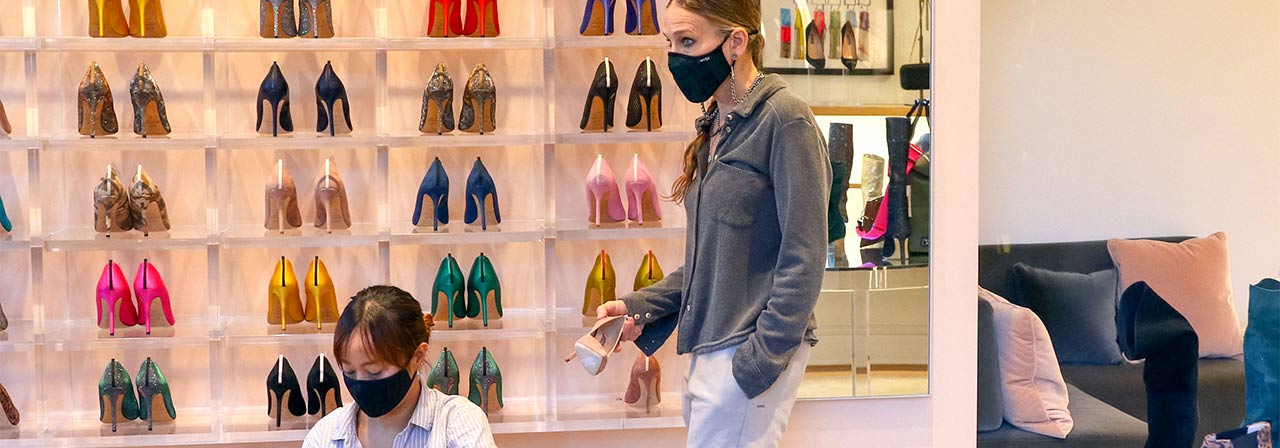Is retail preparing for a resurgence?
Retailers see positive momentum in reduced cases, vaccine adoption and spring weather
Despite economic challenges, global consumers saved $2.9 trillion during the pandemic, with Americans holding more than half the dry powder, according to Bloomberg Economics.
The retail and hospitality industries are cautiously optimistic that these savings, plus U.S. President Joe Biden’s President $1.9 trillion economic stimulus, will set recovery on track in coming months, especially as COVID-19 cases fall, vaccinations increase and warm weather is on the way.
“Natural consumer behavior has been tamped down throughout the pandemic, and typically when that is unleashed you see a significant consumer spend in the industries that have been repressed,” says Naveen Jaggi, President, Retail Advisory Services, JLL. “And what has been repressed the most? People’s ability to travel, dine out with loved ones, and, of course, shop, especially for clothing intended to be worn outside the home.”
Leisure and hospitality
The cash reserves and their potential to fuel an economic recovery has leisure and hospitality businesses hiring staff in anticipation of a surge in demand once people feel safe to spend and to socialize.
Employment in leisure and hospitality in the U.S. increased by 355,000 jobs in February. About 20 percent of the increase was in the food and beverage industry. Hotel bookings are also up. From February 28 – March 6 of this year, total hotel room night demand surpassed 18 million, the highest level since mid-October 2020.
“We are definitely seeing pockets of growth already, especially around the sunbelt,” JLL’s Global Hotels CEO, Gilda Perez-Alvarado, said on Bloomberg Markets.
Travelers vacationing within the U.S. will be drawn to states that they see re-opening safely, with high vaccination rates and low case counts, Jaggi says.
Travel
Airlines are also preparing for better times ahead.
In fact, 15 percent of American travelers said they made travel reservations and/or bookings in the last week and 35.5 percent said their next trip by air will take place by August, according to a study by Destination Analytics. On March 12, 2021, the TSA screened more than 1.3 million travelers , the highest number since the start of the pandemic.
With the renewed interest in travel, major airlines like American and United have scaled back planned layoffs.
“Travel will be a big indicator that we’re returning to normal,” says Jaggi. “Once people start traveling domestically and internationally for business and tourism, that’s when consumers will start to become more comfortable getting out.”
Retail
For the retail industry, recovery is largely dependent on vaccine roll-out.
“States that can move quickly on vaccine deliveries and have higher vaccination adoption will recover faster,” Jaggi says.
Restaurants are already showing positive momentum. Every state in the U.S. now allows indoor dining at varying capacities. While restaurant revenues are still down 20 percent as of March 12, 2021, compared to the same time last year, they have been improving steadily since a surge in cases over the holidays.
“Neighborhood restaurants and shopping centers are expected to be the first to return to normal while enclosed indoor malls will take the longest,” Jaggi says.
The same is true for clothing retailers, anxious to outfit consumers who’ve kept shopping to a minimum for nearly a year. Stores like Anthropologie and Nordstrom are seeing purchasing trends change from loungewear to business casual — indicating that consumers are preparing to socialize once again.
“When people feel comfortable being in public again, demand for entertainment and dining out will skyrocket,” Jaggi says. “Now more than ever people will value time spent with family and friends seeking out these experiences.”
On the investor side, several retail sectors performed extremely well over the past 12 months, and some investors took notice.
“We are seeing tremendous investor demand and pricing at or better than we did pre-COVID for smaller, well-located grocery- and pharmacy-anchored shopping centers,” says Chris Angelone, co-leader of national Capital Markets retail group, JLL. “Other sought-after tenants that have out-performed through the pandemic include home improvement, discount and wholesale clubs. Investors are also seeking out value-add centers of all sizes. The depth of the market still isn’t quite there across the board, but it is well on its way.”
As more and more states ease restrictions and vaccination levels increase, investors who stayed on the sidelines might find themselves competing for opportunities. Angelone notes that, while some markets might rebound faster than others, savvy investors will anticipate the market momentum and seek opportunities accordingly.
Supply chain
As retail prepares for a rebound, the big question is supply chain capacity. In January, ship congestion around the ports of Los Angeles and Long Beach hit some of the highest levels of all time.
To meet consumer demand, supply chain resilience has been top of mind for the industrial, e-commerce and logistics industries. Companies have been looking for alternative solutions to fill holes in the supply chain and fulfill last-mile deliveries.
“COVID-19 has accelerated the adoption rate of e-commerce by up to five years,” said Kris Bjorson, International Director, Retail and E-commerce Distribution, JLL. “It could take up to five years for the supply chain to catch-up.”
E-commerce sales are expected to hit $1.5 trillion by 2025, according to JLL research.
“To keep up with demand, the U.S. will need a billion square feet of new industrial space this decade,” Bjorson says. “We expect at least 7.5% of such demand to be in retail to industrial conversions.”
